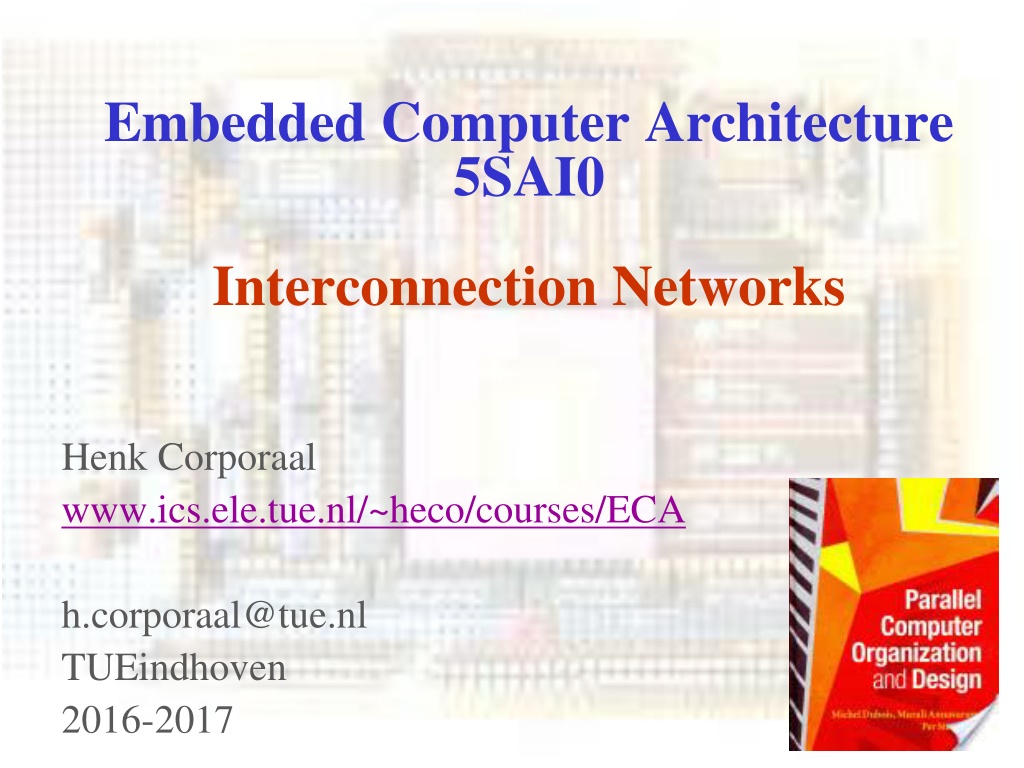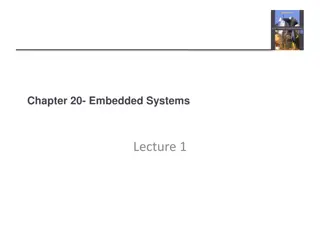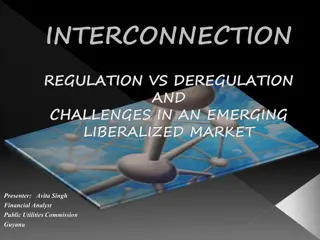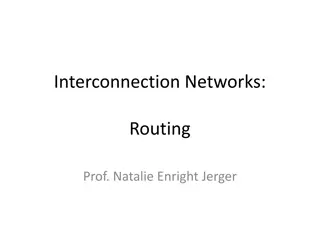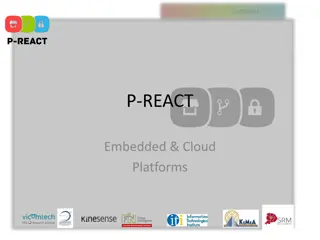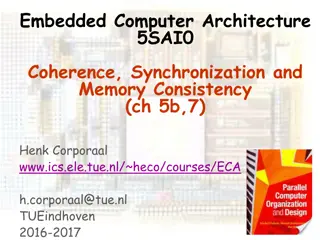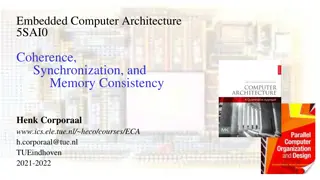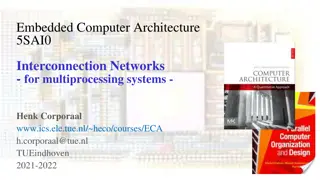Understanding Interconnection Networks in Embedded Computer Architecture
Explore the intricacies of interconnection networks in embedded computer architecture, covering topics such as connecting multiple processors, topologies, routing, deadlock, switching, and performance considerations. Learn about parallel computer systems, cache interconnections, network-on-chip, shared vs. switched networks, mesh networks, communication models, message transfer methods, and packet transmission. Gain insights into the design and operation of interconnection networks for efficient data transfer in embedded systems.
- Interconnection Networks
- Embedded Computer Architecture
- Parallel Computing
- Mesh Networks
- Communication Models
Download Presentation

Please find below an Image/Link to download the presentation.
The content on the website is provided AS IS for your information and personal use only. It may not be sold, licensed, or shared on other websites without obtaining consent from the author. Download presentation by click this link. If you encounter any issues during the download, it is possible that the publisher has removed the file from their server.
E N D
Presentation Transcript
Embedded Computer Architecture 5SAI0 Interconnection Networks Henk Corporaal www.ics.ele.tue.nl/~heco/courses/ECA h.corporaal@tue.nl TUEindhoven 2016-2017 Embedded Computer Architecture 1
Overview Connecting multiple processors or processing elements How to connect Topologies Routing Deadlock Switching Performance: Bandwidth and Latency Material from book: Chapter 6 Embedded Computer Architecture 2
Parallel computer systems M M M L2 Cache Interconnection network Interconnection network L1 L1 L1 CMP CMP CMP P P P Interconnect between processor chips (system area network--san) Interconnect between cores on each chip (Network On Chip -- NOC) Others (not covered): WAN (wide-area network) LAN (local area network) Embedded Computer Architecture 3
Bus (shared) or Network (switched) Network: claimed to be more scalable no bus arbitration point-to-point connections but router overhead Example: NoC with 2x4 mesh routing network node node node node R R R R node node node node R R R R Embedded Computer Architecture 4 4
Example: MESH Switch N.I. Node Switch B Link A Connects nodes: cache and modules, processing elements, processors, Nodes are connected to switches through a network interface (NI) Switch: connects input ports to output ports Link: wires transferring signals between switches Links Width and Clock rate determine Bandwidth Transfer can be synchronous or asynchronous From A to B: hop from switch to switch Decentralized (direct) Embedded Computer Architecture 5
Simple communication model Machine B Machine A out-buffer in-buffer in-buffer out-buffer POINT-TO-POINT REQUEST/REPLY E B F A C G MULTICAST BROADCAST D Point-to-point message transfer Request/reply: request carries ID of sender Multicast: one to many Broadcast: one to all Embedded Computer Architecture 6
Messages and packets Messages contain the information transferred Messages are broken down into packets Packets are sent one by one Payload: message--not relevant to interconnection Header/trailer: contains information to route packet Error Correction Code: ECC to detect and correct transmission errors Embedded Computer Architecture 7
Example: Bus Bus = set of parallel wires Broadcast communication. Needs arbitration Centralized vs distributed arbitration Line (wire) multiplexing (e.g. address & data) Pipelining For example: arbitration => address => data Split-transaction bus vs Circuit-switched bus Properties Centralized (indirect) Low cost Shared Low bandwidth ADDRESS DATA CONTROL ARBITRATION Embedded Computer Architecture 8
Design Characteristics of a Network Topology (how things are connected): Crossbar, ring, 2-D and 3-D meshes or torus, hypercube, tree, butterfly, perfect shuffle, .... Routing algorithm (path used): Example in 2D torus: first east-west, then north-south (avoids deadlock) Switching strategy: Circuit switching: full path reserved for entire message, like the telephone. Packet switching: message broken into separately-routed packets, like the post office. Flow control and buffering (what if there is congestion): Stall, store data temporarily in buffers re-route data to other nodes tell source node to temporarily halt, discard, etc. QoS guarantees Error handling etc, etc. Embedded Computer Architecture 9
Switch / Network Topology Topology determines: Degree: Diameter: max number of links crossed between nodes Average distance: number of links to random destination Bisection: minimum number of links that separate the network into two halves number of links from a node Bisection bandwidth = link bandwidth * bisection Embedded Computer Architecture 10
Bisection Bandwidth Bisection bandwidth: bandwidth across smallest cut that divides network into two equal halves Bandwidth across narrowest part of the network not a bisection cut bisection cut bisection bw= link bw bisection bw = sqrt(n) * link bw Bisection bandwidth is important for algorithms in which all processors need to communicate with all others Embedded Computer Architecture 11
Linear and Ring Topologies Linear array Diameter = n-1; average distance ~n/3 Bisection bandwidth = 1 (in units of link bandwidth) Torus or Ring Diameter = n/2; average distance ~ n/4 Bisection bandwidth = 2 Natural for algorithms that work with 1D arrays Embedded Computer Architecture 12
Meshes and Tori Two dimensional mesh Diameter = 2 * (sqrt( n ) 1) Bisection bandwidth = sqrt(n) Two dimensional torus Diameter = sqrt( n ) Bisection bandwidth = 2* sqrt(n) Generalizes to higher dimensions Natural for algorithms that work with 2D and/or 3D arrays Embedded Computer Architecture 13
Hypercubes Number of nodes n = 2d for dimension d Diameter = d Bisection bandwidth = n/2 0d 1d 2d 3d 4d Popular in early machines (Intel iPSC, NCUBE, CM) Lots of clever algorithms Extension: k-ary n-cubes (k nodes per dimension, so kn nodes) Greycode addressing: Each node connected to others with 1 bit different 110 111 010 011 100 101 000 001 Embedded Computer Architecture 14
Trees Diameter = log n. Bisection bandwidth = 1 Easy layout as planar graph Many tree algorithms (e.g., summation) Fat trees avoid bisection bandwidth problem: More (or wider) links near top Example: Thinking Machines CM-5 Embedded Computer Architecture 15
Fat Tree example A multistage fat tree (CM-5) avoids congestion at the root node Randomly assign packets to different paths on way up to spread the load Increase degree near root, decrease congestion Embedded Computer Architecture 16
Common Topologies Type Degree Diameter Ave Dist Bisection 1D mesh 2 N-1 N/3 1 2D mesh 4 2(N1/2 - 1) 2N1/2 / 3 N1/2 3D mesh 6 3(N1/3 - 1) 3N1/3 / 3 N2/3 nD mesh 2n n(N1/n - 1) nN1/n / 3 N(n-1) / n Ring 2 N/2 N/4 2 2D torus 4 N1/2 N1/2 / 2 2N1/2 Hypercube Log2N 2D Tree n=Log2N n/2 2Log2N ~2Log2 N 1 1 1 N/2 3 Crossbar N-1 N2/2 N = number of nodes, n = dimension Embedded Computer Architecture 17
More examples Hypercube 2D-Grid/Mesh 2D-Torus Assume 64 nodes: Criteria Bus Ring 2D- Mesh 2D-torus 6-cube Fully connected Performance Bisection bandwidth 1 2 8 16 32 1024 Cost Ports/switch Total #links 3 5 5 7 64 1 128 176 192 256 2080 Embedded Computer Architecture 18
Butterflies with n = (k-1)2k switches Connecting 2k processors, with Bisection bandwidth = 2*2k Cost: lots of wires 2log(k) hop-distance for all connections, however blocking possible Used in BBN Butterfly Natural for FFT Switch PE O 1 O 1 O 1 O 1 Multistage butterfly network: k=3 Butterfly switch Embedded Computer Architecture 19
Real machines use all kinds of topologies Red Storm (Opteron + Cray network, future) Blue Gene/L 3D Mesh 3D Torus SGI Altix Fat tree Cray X1 4D Hypercube* older newer Myricom (Millennium) Arbitrary Quadrics (in HP Alpha server clusters) IBM SP Fat tree Fat tree (approx) SGI Origin Hypercube Intel Paragon (old) 2D Mesh BBN Butterfly (really old) Butterfly Embedded Computer Architecture 20
Routing algorithms Dimension-order routing (deterministic) = route 1-dimension at a time Embedded Computer Architecture 21
Deadlock 4 necessary conditions for deadlock, given a set of agents accessing a set of shared resources: Mutual exclusion Only one agent can access the resource at a time No preemption No mechanism can force agent to relinquish acquired resource Hold and wait Agent holds on its acquired resources while waiting for others Circular wait A set of agents wait on each other to acquire each others resources => no one can make any progress shared resources can be SW or HW: critical sections, disk, printer, .. In NW: Agents = packets; resources = physical or logical channels Embedded Computer Architecture 22
Deadlock avoidance Assume Mesh or Tori Assume that packets are free to follow any route In this example each node is trying to send a packet to the diagonally opposite node at the same time, e.g. (0,0) to (1,1) To avoid link conflicts, (1,0) uses c3 then c0, and (0,0) uses c0 then c1, etc... The resource acquisition graph (or channel-dependency graph) on the right shows circular wait => DEADLOCK Possible Embedded Computer Architecture 23
Deadlock avoidance Enforce dimension-order routing (xy-routing) Packet moves first horizontally, then vertically No cycle!!! Problem: contention for channels If (0,0) wants to send a packet to (1,1), it must first use c3 If c3 is occupied, could take alternate route c0 => c1 To avoid deadlocks, use virtual channels Alternate set of channels in which yx routing is enforced e.g., c 1 If c3 is occupied, the packet can safely route through c 0 and c 1. Embedded Computer Architecture 24
Routing in butterflies: Omega NW Use source and/or destination addresses 0 0 USE THE DESTINATION ADDRESS IN THIS CASE, 3 BITS <d2,d1,d0> 1 1 USE ith BIT OF THE DESTINATION (di) TO SELECT UPPER OR LOWER OUTPUT PORT FOR STAGE n-1-i 0 => UP 1 => DOWN 2 2 3 3 4 4 5 5 EXAMPLE: ROUTE FROM 4 TO 6 DESTINATION ADDRESS IS 110 DOWN IN STAGE 0 DOWN IN STAGE 1 UP IN STAGE 2 6 6 7 7 STAGE 2 STAGE 0 STAGE 1 Embedded Computer Architecture 25
Switch micro-architecture Physical channel = link Virtual channel = buffers + link link is time-multiplexed among flits Embedded Computer Architecture 26
Switching strategy Defines how connections are established in the network Circuit switching = Establish a connection for the duration of the network service Example: circuit switching in mesh Establish path in network Transmit packet Release path Low latency; high bandwidth Good when packets are transmitted continuously between two nodes Packet switching = Multiplex several services by sending packets with addresses Example: remote memory access on a bus Send a request packet to remote node Release bus while memory access takes place Remote node sends reply packet to requester In between send and reply, other transfers are supported Example: remote memory access on a mesh Embedded Computer Architecture 27
2 Packet switching strategies store-and-forward = packet switching, packets move from node to node and are stored in buffers in each node cut-through = packets move through nodes in pipeline fashion, so that the entire packet moves through several nodes at one time Two implementations of cut-through: Virtual cut-throughswitching: The entire packet is buffered in the node when there is a transmission conflict When traffic is congested and conflicts are high, virtual cut through behaves like store-and-forward Wormhole switching: Each node has enough buffering for a flit (flow control unit) A flit is made of consecutive phits (physical transfer unit), which basically is the width of a link (= number of bits transferred per clock) A flit is a fraction of the packet, so the packet can be stored in several nodes (one or more flits per node) on its path Note: In virtual cut-through the flit is the whole packet Embedded Computer Architecture 28
Latency models Sender overhead: creating the envelope and moving packet to NI Time of flight: time to send a bit from source to destination when the route is established and without conflicts. (Includes switching time.) Transmission time: time to transfer a packet from source to destination, once the first bit has arrived at destination phit: number of bits transferred on a link per cycle Basically: packet size/phit size flit: flow control unit Embedded Computer Architecture 29
Latency models Routing time: time to set up switches Switching time: depends on switching strategy (store-and-forward vs cut-through vs circuit-switched). Affects time of flight and included in that. Receiver overhead: time to strip out envelope and move packet in Embedded Computer Architecture 30
Measures of latency Routing distance: Number of links traversed by a packet Average routing distance: average over all pairs of nodes Network diameter: longest routing distance over all pairs of nodes Packets of a message can be pipelined Transfer pipeline has 3 stages Sender overhead-->transmission -->receiver overhead Total message time = time for the first packet + (n-1)/pipeline throughput End-to-end message latency = sender overhead + time of flight + transmission time + routing time + (n-1) * MAX(sender ov, transmission time, receiver overhead) Embedded Computer Architecture 31
summarize what you learned Embedded Computer Architecture 32
EXTRA SLIDES Embedded Computer Architecture 33
Comparison between topologies Interconnection network Crossbar switch Butterfly (built from k- by-k switches) k-ary tree Switch degree N Network diameter 1 Bisection width N Network size N k logk N N/2 N k+1 2logk N 1 N Linear array 2 N-1 1 N Ring 2 N/2 2 N n-by-n mesh 4 2(n-1) n N=n2 n-by-n torus 4 n 2n N=n2 k-dimensional hypercube k-ary n-cube k k 2k-1 N=2k 2k nk/2 2kn-1 N=nk Switch degree: # of ports for each switch (switch complexity) Network diameter: worst-case routing distance between any two nodes Bisection width: # of links in bisection (worst-case bandwidth) Network size: # of nodes Embedded Computer Architecture 34
Flow control Refers to mechanisms to handle conflicts in switch-based networks Buffers at input and output ports In virtual cut-through: buffer for entire packet In wormhole: buffer for integral number of flits Link-level flow control Handshake signal Rdy indicates whether flits can be transmitted to the destination Buffering for cut-through (whole packet) vs wormhole (a few flits Output ports Input ports Transmit Rdy crossbar 4-by-4 Embedded Computer Architecture 35
Switching strategies Circuit switching: Route is set up first Routing time = l x r + time of flight R to set each switch, l number of switches, and tof to inform the node back Packet switching Route is set up as the packet moves from switch to switch Store-and-forward, cut-through Cut-through switching Store-and-forward switching Switch L L-2 cycles Switch 2 Switch 1 Time Embedded Computer Architecture 36
Switching strategies Packet latency = sender ov + tof (incl.Switching time) + transmission time + routing time + receiver ov R: routing time per switch; n: # of phits; l: # of switches; tof: time of flight Circuit switching Packet latency = sender ov + 2xtof + n + lxr + receiver ov Tof = l because there are l switches and nb of phits to switch is one Store-and-forward Packet latency = sender ov + tof + n + lxr + receiver ov Tof = lxn because switching involves a whole packet (n phits) Cut-through switching Packet latency = sender ov + tof + n + lxr + receiver ov Tof = l as in circuit switching Virtual cut-through switching Similar to circuit switching but better bw Note that when traffic is congested, cut-through = store-and-forward Wormhole switching Handles conflicts differently Switch port has at least enough buffering for a flit Blocked packets simply stay in the flit buffers provided in their path Packet flits hold circuits in multiple switches Embedded Computer Architecture 37
Bandwidth models Bottlenecks increase latency Transfers are pipelined Effective bandwidth = packet_size/max(sender ov, receiver ov, transmission time) Network contention affects latency and effective bandwidth (not counted in above formula) Bisection width Network is seen as a graph Vertices are switches and edges are links Bisection is a cut through a minimum set of edges such that the cut divides the network graph into two isomorphic --i.E., Same-- subgraphs Example: mesh Measures bandwidth when all nodes in one subgraph communicate only with nodes in the other subgraph Aggregate bandwidth Bandwidth across all links divided by the number of nodes Embedded Computer Architecture 38
Topologies Indirect networks: in is centralized Bus Crossbar switch Multistage interconnection network (min) 0 1 2 3 4 5 0 2-BY-2 CROSSBAR 6 7 0 0 1 1 1 2 2 2 3 3 3 4 PERFECT_SHUFFLE PERFECT_SHUFFLE PERFECT_SHUFFLE 5 6 4 4 5 5 7 6 6 CROSSBAR 7 7 OMEGA NETWORK Embedded Computer Architecture 39
Topologies Indirect networks: in is centralized Tree Butterfly 0 0 1 1 2 2 3 3 4 5 2 3 6 0 1 4 4 5 5 BINARY TREE 6 6 7 7 BUTTERFLY: EMBEDDED TREES Best to connect different types of nodes Embedded Computer Architecture 40
Topologies Direct networks: nodes are directly connected to one another Decentralized Linear array and ring Mesh and tori Embedded Computer Architecture 41
Topologies Direct networks: nodes are directly connected to one another Hypercube and k-ary n-cube Embedded Computer Architecture 42
Routing algorithms Butterfly network USE RELATIVE ADDRESS BITWISE EXCLUSIVE OR OF SOURCE AND DESTINATION ADDRESSES TO FORM THE ROUTING ADDRESS IF BIT i IS ZERO, ROUTE STRAIGHT IF BIT i IS ONE, ROUTE ACROSS 0 0 1 1 2 2 3 3 EXAMPLE: ROUTE FROM 4 TO 6 SOURCE: 100 DESTINATION: 110 EX-OR: 010 4 4 5 5 6 6 7 7 STAGE 2 STAGE 0 STAGE 1 Embedded Computer Architecture 43
